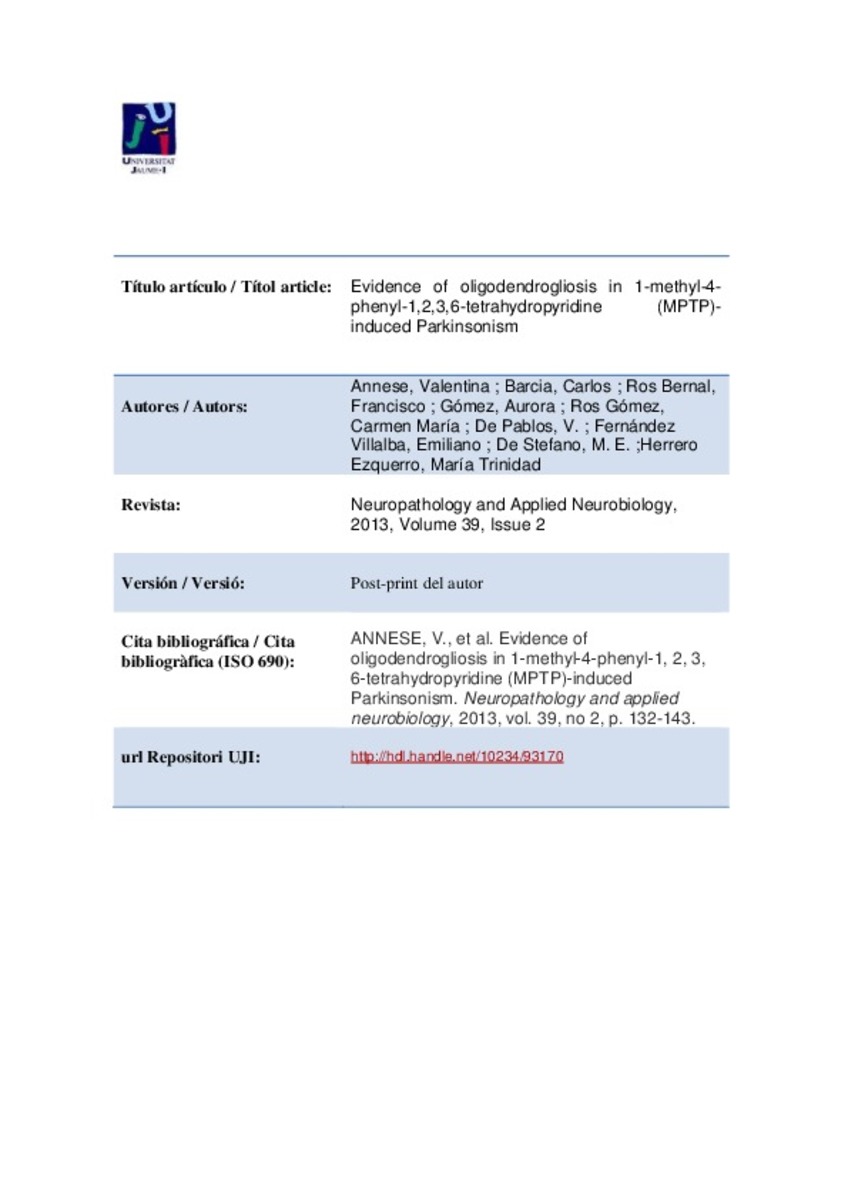Mostra el registre parcial de l'element
Evidence of oligodendrogliosis in 1-methyl-4-phenyl-1,2,3,6-tetrahydropyridine (MPTP)-induced Parkinsonism
| dc.contributor.author | Annese, Valentina | |
| dc.contributor.author | Barcia, Carlos | |
| dc.contributor.author | Ros Bernal, Francisco | |
| dc.contributor.author | Gómez, Aurora | |
| dc.contributor.author | Ros Gómez, Carmen María | |
| dc.contributor.author | De Pablos, Vicente | |
| dc.contributor.author | Fernández Villalba, Emiliano | |
| dc.contributor.author | De Stefano, Maria Egle | |
| dc.contributor.author | Herrero Ezquerro, María Trinidad | |
| dc.date.accessioned | 2014-05-21T18:10:31Z | |
| dc.date.available | 2014-05-21T18:10:31Z | |
| dc.date.issued | 2013 | |
| dc.identifier.issn | 0305-1846 | |
| dc.identifier.issn | 1365-2990 | |
| dc.identifier.uri | http://hdl.handle.net/10234/93170 | |
| dc.description.abstract | Aims: Mice and nonhuman primates administered with 1-methyl-4-phenyl-1,2,3,6-tetrahydropyridine (MPTP) represent elective experimental models of Parkinsonism, in which degeneration of the nigrostriatal dopaminergic pathway is associated with prominent neuroinflammation, characterized by activated microglia and astrocytes in both substantia nigra (SN) and striatum. To date, it is unknown whether oligodendrocytes play a role in these events. Methods: We performed a detailed qualitative and quantitative analysis of oligodendrocyte-associated changes induced by acute and chronic MPTP treatment, in the SN and striatum of mice and macaques respectively. Oligodendrocytes were immunolabelled by cell-specific markers and analysed by confocal microscopy. Results: In both experimental models, MPTP treatment induces an increase in oligodendrocyte cell number and average size, as well as in the total area occupied by this cell type per tissue section, accompanied by evident morphological changes. This multifaceted array of changes, herein referred to as oligodendrogliosis, significantly correlates with the reduction in the level of dopaminergic innervation to the striatum. Conclusions: This event, associated with early damage of the dopaminergic neurone axons and of the complex striatal circuits of which they are part, may result in an important, although neglected, aspect in the onset and progression of Parkinsonism. | ca_CA |
| dc.format.extent | 28 p. | ca_CA |
| dc.format.mimetype | application/pdf | ca_CA |
| dc.language.iso | eng | ca_CA |
| dc.publisher | Wiley | ca_CA |
| dc.relation.isPartOf | Neuropathology and Applied Neurobiology, 2013, Volume 39, Issue 2 | ca_CA |
| dc.rights | © 2012 The Authors. Neuropathology and Applied Neurobiology © 2012 British Neuropathological Society. "The definitive version is available at www3.interscience.wiley.com" | ca_CA |
| dc.rights.uri | http://rightsstatements.org/vocab/InC/1.0/ | * |
| dc.subject | glial response | ca_CA |
| dc.subject | MPTP | ca_CA |
| dc.subject | neurodegeneration | ca_CA |
| dc.subject | oligodendrocytes | ca_CA |
| dc.subject | Parkinson’s disease | ca_CA |
| dc.title | Evidence of oligodendrogliosis in 1-methyl-4-phenyl-1,2,3,6-tetrahydropyridine (MPTP)-induced Parkinsonism | ca_CA |
| dc.type | info:eu-repo/semantics/article | ca_CA |
| dc.identifier.doi | http://dx.doi.org/10.1111/j.1365-2990.2012.01271.x | |
| dc.rights.accessRights | info:eu-repo/semantics/openAccess | ca_CA |
| dc.relation.publisherVersion | http://onlinelibrary.wiley.com/doi/10.1111/j.1365-2990.2012.01271.x/pdf | ca_CA |
| dc.type.version | info:eu-repo/semantics/acceptedVersion |
Fitxers en aquest element
Aquest element apareix en la col·lecció o col·leccions següent(s)
-
MED_Articles [646]
Articles de publicacions periòdiques







